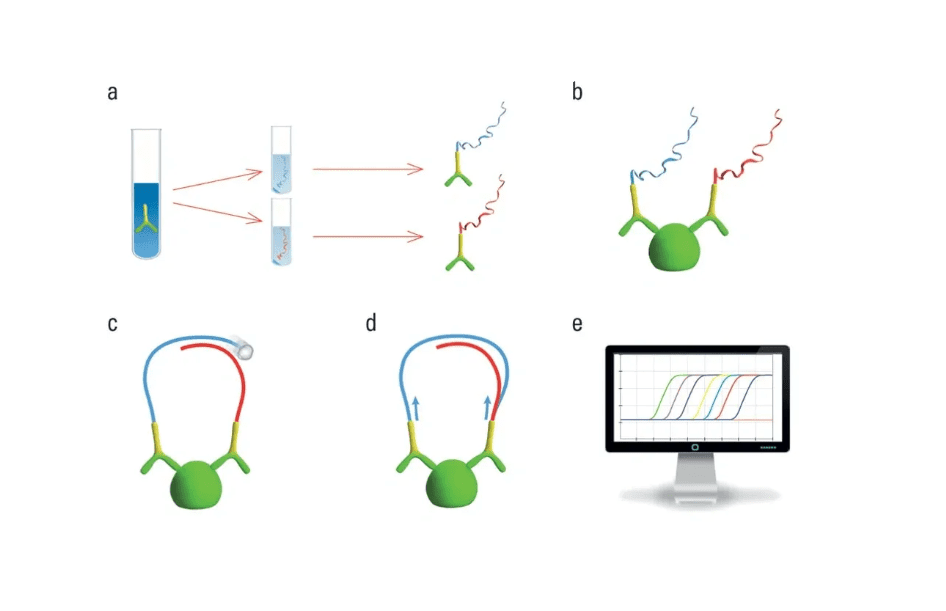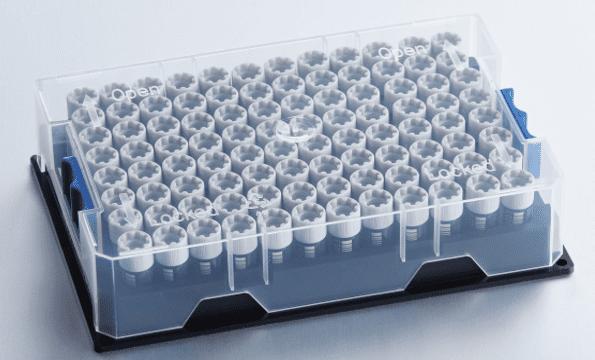Protein biomarker measurement with Olink® proteomics
Protein biomarkers, in conjunction with other omics markers, can be utilized for the prediction of drug response, stratification of patient populations, and gaining of insights into disease biology.
Olink assay offers a high-throughput solution for the discovery of protein biomarkers through thoroughly validated assays that exhibit exceptional specificity at high-multiplex levels. By leveraging Olink Proteomics® Proximity Extension Assay (PEA) technology, PicoImmune’s protein biomarker immunoassay services enable the detection and quantification of circulating proteins to provide an in-depth understanding of disease biology and drug efficacy.
To adopt a multiomics approach, this proteomics service can be combined with PicoImmune's other high-throughput and multiplex approaches to offer a comprehensive understanding of molecular changes contributing to development, disease, and drug response in preclinical studies and clinical trials.
Our Olink proteomics assays have many benefits
- Encompasses all major biological pathways and functions within the low abundant plasma proteome.
- Covers a wide range of disease areas including cardiovascular disease, oncology, neurology, inflammation, immuno-oncology, and more.
- Explores various biological processes such as cardio-metabolism, cell regulation, neuro-exploratory studies, immune response mechanisms, development processes, metabolism patterns, and organ damage assessment.
- Enables scaling up to approximately 3,000 high-throughput multiplex assays without compromising sensitivity and specificity.
- Measures the extensive dynamic range of the plasma proteome accurately.
- Provides high-quality and reproducible proteomic data.
- Incorporates in-well controls for each assay step to ensure data integrity without requiring replicates.
- Includes comprehensive quality controls in each assay for complete visibility and control over technical performance as well as sample analysis itself.
- Features calibrators/controls within every well to enhance assay accuracy and parallelism by maintaining identical assay matrix for both calibrators/controls and samples.
How it works

- a) Target-specific antibodies are conjugated to different oligos (blue and red, respectively), thereby generating PEA probes A and B.
- (b) Subsequently, the PEA probes are incubated with the samples as well as a dilution series of the antigen standard in either a 96-well plate or test tubes, facilitating the binding of the probes to the target protein.
- (c) Probes that exhibit close proximity binding undergo extension through a DNA-polymerization event, leading to the creation of real-time PCR amplicons.
- (d) The resulting extension products are combined with a real-time PCR mix (d), followed by amplification of DNA within a real-time PCR instrument (e).
Olink’s PEA technology
Proximity Extension Assay (PEA) technology
- The Olink's Proximity Extension Assay (PEA) utilizes a unique and innovative dual recognition DNA-coupled methodology, which offers exceptional specificity and sensitivity in readout.
- The Olink assay effectively addresses the challenges encountered in conventional protein detection through an elegant and robust solution based on DNA counting.
- The method involves the use of two matched antibodies against each target antigen, with each antibody pair labeled with distinct complementary DNA oligo tags referred to as "DNA barcodes". When these antibodies bind to the same target protein in a solution, the corresponding DNA oligo strands are brought into close proximity and form stable hybridization, enabling subsequent DNA extension. Each antibody pair possesses a unique "DNA barcode" that is then amplified for quantification using qPCR or sequencing techniques.
About our Olink proteomics assay
Service features

- Fully validated and quality-controlled assays
- Flexible assay design options: pre-made panels (92 or 45 protein assays) or customizable panels (up to 21 proteins)
- Highly robust and reproducible assay suitable for screening on both small and large scales
- State-of-the-art platforms utilized, with readout performed using the Fluidigm® BioMark™ HD system
- Quick turnaround time, providing concise and quantitative data within 2-4 weeks
- Comprehensive study report delivered in a high-quality publication-style format
Sample requirements

- Minimal sample consumption (as low as 1 µL of plasma/serum) due to quantification of the resulting DNA amplicon by microfluidic qPCR.
- However, we suggest ~20 µl sample should be shipped to us for accurate pipetting.
- A wide range of accepted biologic sample types, including serum, plasma, or almost any type of biological sample.
Popular assay panels

- The Olink® Target 96 & Target 48 panels are designed to focus on specific disease biology, allowing for the relative quantification of up to 92 carefully selected proteins across a maximum of 88 samples simultaneously.
- With Olink® Flex, we have the flexibility to combine and select up to 21 proteins from a library of approximately 200 validated biomarkers into one panel with absolute quantification capability for up to 21 assays per panel and accommodating up to 40 samples per kit. Through Olink® Focus, we can utilize custom panels consisting of up to 21 proteins.
FAQ: Luminex vs Olink multiplex immunoassays
We offer two different multiplex assays for cytokine detection, Luminex and Olink. These assays use different technologies, and have panels targeting different but overlapping sets of cytokines for Luminex and for Olink.
- Which assay is the most sensitive? Overall, both assays have sensitivity in the low pg/ml range. However, due to variations in antibody pairs between platforms, one platform may be slightly better for a specific target. For instance, we observe better sensitivity with Luminex for IL-4 and IL-5, as well as IL-33; whereas Olink shows similar sensitivity for many other cytokines.
- Is there a difference in sample requirements? Yes, Olink only requires approximately 20 µl of sample, while Luminex necessitates around 100 µl for serum or plasma and 200 µl for supernatants or homogenates. Both platforms can handle matrices such as serum, plasma, tissue lysates etc., but it is important to ensure that all samples being compared are collected using the same matrix.
- What about price and number of samples? Our standard Luminex panels are priced per sample regardless of the number submitted since the assay allows flexibility in running various batch sizes. However, please note that a full plate can accommodate a maximum of 46 duplicate samples or 92 singlets (plus controls). Olink assays have a fixed array configuration that can accommodate up to 88 samples plus controls; they are charged per array used. Consequently, Olink becomes cost-effective when close to utilizing a full array of samples.
- Are there any batch effects? Like any assay method, these assays may exhibit some run-to-run differences referred to as batch effects. Fortunately, our scientists employ methods that largely correct these effects.
- Are there any other technical issues? There may be concerns regarding cross-reactivity or non-specific binding, particularly in the case of multiplex assays. We have the capability to eliminate nonspecific binding artifacts in Luminex assays (refer to J Immunol 204:3425-3433), but not in Olink assays.
- Should samples be run in duplicate? Our standard pricing includes duplicate wells for Luminex, and we generally recommend running duplicates or triplicates to account for technical variability through averaging. However, certain experimental designs involving cell stimulation may require replicates of each stimulation, which are then run only once on Luminex. Additionally, longitudinal time series experiments can impact statistical power. For Olink assays, technical coefficients of variation are low, making duplicates potentially less necessary.
- Can I perform multiple assays on the same samples? Yes, it is possible if sample volume permits. When running the assays sequentially, a slight freeze-thaw effect might occur. While this typically does not significantly affect most cytokines' results, subtle differences could arise. Multiple freeze-thaw cycles can certainly lead to degradation of certain susceptible cytokines.
More Assay Panels
Olink® Target 96 & 48 panels for targeted protein biomarker discovery enable faster, better-informed decisions in human protein biomarker research by providing high-multiplex immunoassays that do not compromise on either data quality or performance. Categorization of the proteins included in each panel is carried out via referral to widely used public-access bioinformatic databases, including Uniprot, Human Protein Atlas, Gene Ontology (GO), etc.
- Olink Target 48 Cytokine Panels offer a broad selection of proteins associated with biological functions linked to inflammation.
- Olink Target 96 Immuno-Oncology Panels offer a broad selection of proteins associated with biological functions linked to immune response and immunotherapy.
- Olink Target 96 Oncology Panels offer proteins associated with biological functions linked to the initiation and progression of cancer, such as angiogenesis, cell communication, cellular metabolic processes, apoptosis, cell proliferation/differentiation etc.
- Olink® Target 96 biological process-focused Panels offer a broad selection of proteins associated with the important biological functions, Cell Regulation, Development, Metabolism and Organ Damage.
- Olink Target 96 Neurology Panels offer proteins associated with neurological functions and associated diseases.
- Olink Target 96 Cardiovascular Panels offer proteins associated with biological functions linked to cardiovascular diseases.
